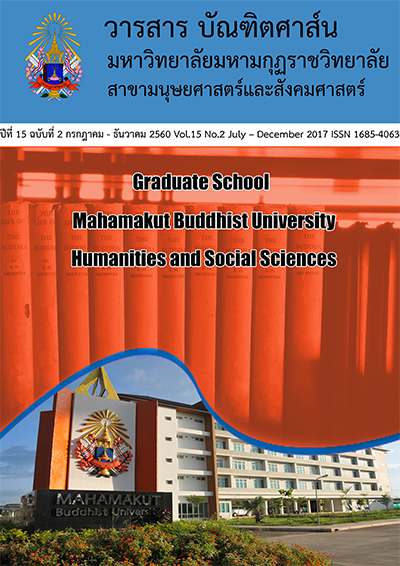นวัตกรรมสร้างสรรค์ทางธุรกิจเพื่อการส่งออกกับนโยบายไทยแลนด์ 4.0
คำสำคัญ:
นวัตกรรม, ธุรกิจเพื่อการส่งออก, นโยบายไทยแลนด์ 4.0บทคัดย่อ
“ไทยแลนด ์ 4.0” เป็นวิสัยทัศนเ์ชิงนโยบายการ พัฒนาเศรษฐกิจของประเทศไทย หรือ โมเดลพัฒนา เศรษฐกิจของรัฐบาล ภายใต้การนำของพลเอกประยุทธ ์ จันทร์โอชา นายกรัฐมนตรี และหัวหน้า คณะรัก ษาความสงบแห่งชาติ (คสช.) ที่เข้ามาบริหารประเทศบนวิสัยทัศน์ ที่ว่า “มั่นคงมั่งคั่งและยั่งยืน” ที่มีภารกิจสำคัญในการ ขับเคลื่อนปฏิรูปประเทศด้านต่าง ๆ เพื่อปรับแก้ จัดระบบ ปรับทิศทาง และสร้างหนทางพัฒนาประเทศให้เจริญ สามารถรับมือกับโอกาส และภัยคุกคามแบบใหม่ ๆ ที่ เปลี่ยนแปลงอย่างเร็ว รุนแรงในศตวรรษที่ 21 ได้ทักษะ (Skills) ให้ความสำคัญกับการจัดการความรู้การแบ่งปัน ข้อมลู ข่าวสาร และการดึงความรู้ทั้ง ความรู้ซ่อนเร้น (Tacit Knowledge) และความรู้ที่ชัดแจ้ง (Explicit Knowledge) จากบุคคลออกมาให้ได้ (5) การสร้างการเรียนรู้ขององค์กร และการเรียนรู้จากประสบการณ์ องค์กรแห่งนวัตกรรม ต้องมีพันธะสัญญากับ การสร้างการเรียนรู้ขององค์กร และต้องพัฒนาองค์กรใหมี้รูปแบบเป็นองค์กรแห่งการ เรียนรู้ (Learning Organization) ซึ่งเป็นการสร้างองค์กร ให้มีทักษะ การรับการเปลี่ยนรูป การดัดแปลงความรู้ การมีพฤติกรรมที่สะท้อนออกมาเป็นความรู้ใหม่ และการ หยั่งรู้ (6) การจัด สรรทรัพยากรและงบประมาณ เพื่อ สนับ สนุนการบรรลุเป้าหมาย โดยองค์กรต้องเลือกกลยุทธ์ ที่มีความเหมาะสม (Strategic Fit Model) กับจุดแข็ง จุดอ่อน โอกาส อุปสรรค และสิ่งแวดล้อมภายนอก องค์กร ซึ่งต้องมีการจัดสรรทรัพยากร และงบประมาณ ที่มีอยู่ให้เหมาะสม เพื่อสนับสนุนให้สามารถบรรลุ เป้าหมายได้อย่างมีประสิทธิภาพ
เอกสารอ้างอิง
ศุภชัย หล่อโลหการ, และคณะ. (2553). การจัดการนวัตกรรมสำหรับผู้บริหาร = Innovation Management for Executives (IMEs). กรุงเทพมหานคร: สำนักงานนวัตกรรมแห่งชาติกระทรวงวิทยาศาสตร์ และเทคโนโลยี.
Cornell University, INSEAD, and WIPO. (2015). The Global Innovation Index 2015: Effective Innovation Policies for Development, Fontainebleau, Ithaca, and Geneva.
Deshpande, R., & Farley, J. U. (2004). Organizational culture, market orientation, innovativeness and firm performance. International Journal of Research in Marketing, 22, 3-22.
Elkington John. (2004). Enter the triple bottom line. The triple bottom line: Does it all add up, 1–16.
Gundling Ernest. (2000). The 3M Way to Innovation: Balancing People and Profit. New York: Kodansha.
Hartmann, Andreas. (2006). The Role of Organizational Culture in Motivating Innovative Behaviour in Construction Firms. Construction Innovation. 6 (3): 159-172. Retrieved March 12, 2017 from Emerald Group Publishing.
Ismail.M., Domil.A., and Isa.A. (2014). Managerial Competence, Relationship Quality and Competitive Advantage among SME Exporters. Proceedings of the 5th Indonesia International Conference on Innovation, Entrepreneurship and Small Business. Social and Behavioral Sciences 115. 138-146
James M. Higgins. (1995) "Innovation: The core competence", Planning Review, Vol. 23 Issue: 6, pp.32-36, doi, 10.1108/eb054532
Julian, C.C., and Ahmed, Z.U. (2012). Factors impacting international entrepreneurship in Malaysia. Journal of Small Business and Enterprise Development, 19(2), pp.229-245.
Mahdi and Almsafir.(2014). The Role of Strategic Leadership in Building Sustainable http://www.drborworn.com/articledetail.asp?id=16223ข้อมูลออนไลน์ (เข้าถึงเมื่อ 18 /10/ 17)
ดาวน์โหลด
เผยแพร่แล้ว
รูปแบบการอ้างอิง
ฉบับ
ประเภทบทความ
สัญญาอนุญาต
บทความวิชาการและบทความวิจัยในวารสารฉบับนี้ถือเป็นความรับผิดชอบของผู้เขียนเท่านั้น บทความที่ได้รับการตีพิมพ์ในวารสารบัณฑิตศาส์น ถือเป็นลิขสิทธิ์ของมหาวิทยาลัยมหามกุฏราชวิทยาลัย ตามพระราชบัญญัติลิขสิทธิ์



